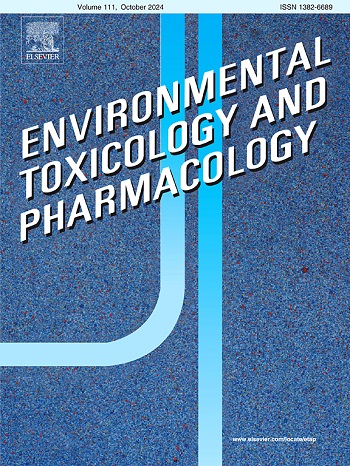Exploring the mechanisms of hippocampal neurotoxicity induced by cypermethrin: Insights from integrated miRNA-seq and mRNA-seq analysis
IF 4.2
3区 环境科学与生态学
Q2 ENVIRONMENTAL SCIENCES
引用次数: 0
Abstract
Cypermethrin (CMN) is a synthetic pyrethroid insecticide known for its neurotoxic effects, particularly in the hippocampus. To investigate the underlying molecular mechanisms, we conducted integrated microRNA (miRNA) and messenger RNA (mRNA) sequencing in HT22 hippocampal cells treated with 400 μM CMN. We identified 36 differentially expressed miRNAs and 170 target mRNAs. Gene Ontology (GO) and Kyoto Encyclopedia of Genes and Genomes (KEGG) enrichment analyses revealed significant involvement in cell adhesion, extracellular matrix organization, and signaling pathways such as phosphoinositide 3-kinase–protein kinase B signaling pathway (PI3K-Akt), mitogen-activated protein kinase (MAPK), and extracellular matrix (ECM)–receptor interaction. Using six topological algorithms, three hub genes (Col1a2, Fn1, and Pdgfrb) were finally identified. In addition, a miRNA–mRNA regulatory network was constructed, and expression patterns of key miRNAs and mRNAs were validated via reverse transcription polymerase chain reaction (RT-PCR). These findings highlight the critical role of the miRNA–mRNA regulatory network in CMN-induced neurotoxicity. The study provides valuable insights into potential therapeutic targets and preventive strategies for CMN-associated hippocampal damage.
探索氯氰菊酯诱导海马神经毒性的机制:来自miRNA-seq和mRNA-seq综合分析的见解
氯氰菊酯(CMN)是一种合成的拟除虫菊酯杀虫剂,以其神经毒性作用而闻名,特别是在海马体内。为了研究其潜在的分子机制,我们对400 μM CMN处理的HT22海马细胞进行了microRNA (miRNA)和信使RNA (mRNA)的整合测序。我们鉴定了36个差异表达的mirna和170个靶mrna。基因本体(GO)和京都基因与基因组百科(KEGG)富集分析显示,细胞粘附、细胞外基质组织和信号通路(如磷酸肌苷3-激酶-蛋白激酶B信号通路(PI3K-Akt)、丝裂原活化蛋白激酶(MAPK)和细胞外基质(ECM) -受体相互作用)显著参与。使用六种拓扑算法,最终确定了三个枢纽基因(Col1a2, Fn1和Pdgfrb)。此外,构建miRNA-mRNA调控网络,通过逆转录聚合酶链反应(RT-PCR)验证关键mirna和mrna的表达模式。这些发现强调了miRNA-mRNA调控网络在cmn诱导的神经毒性中的关键作用。该研究为cmn相关海马损伤的潜在治疗靶点和预防策略提供了有价值的见解。
本文章由计算机程序翻译,如有差异,请以英文原文为准。
求助全文
约1分钟内获得全文
求助全文
来源期刊
CiteScore
7.00
自引率
4.70%
发文量
185
审稿时长
34 days
期刊介绍:
Environmental Toxicology and Pharmacology publishes the results of studies concerning toxic and pharmacological effects of (human and veterinary) drugs and of environmental contaminants in animals and man.
Areas of special interest are: molecular mechanisms of toxicity, biotransformation and toxicokinetics (including toxicokinetic modelling), molecular, biochemical and physiological mechanisms explaining differences in sensitivity between species and individuals, the characterisation of pathophysiological models and mechanisms involved in the development of effects and the identification of biological markers that can be used to study exposure and effects in man and animals.
In addition to full length papers, short communications, full-length reviews and mini-reviews, Environmental Toxicology and Pharmacology will publish in depth assessments of special problem areas. The latter publications may exceed the length of a full length paper three to fourfold. A basic requirement is that the assessments are made under the auspices of international groups of leading experts in the fields concerned. The information examined may either consist of data that were already published, or of new data that were obtained within the framework of collaborative research programmes. Provision is also made for the acceptance of minireviews on (classes of) compounds, toxicities or mechanisms, debating recent advances in rapidly developing fields that fall within the scope of the journal.

 求助内容:
求助内容: 应助结果提醒方式:
应助结果提醒方式:


